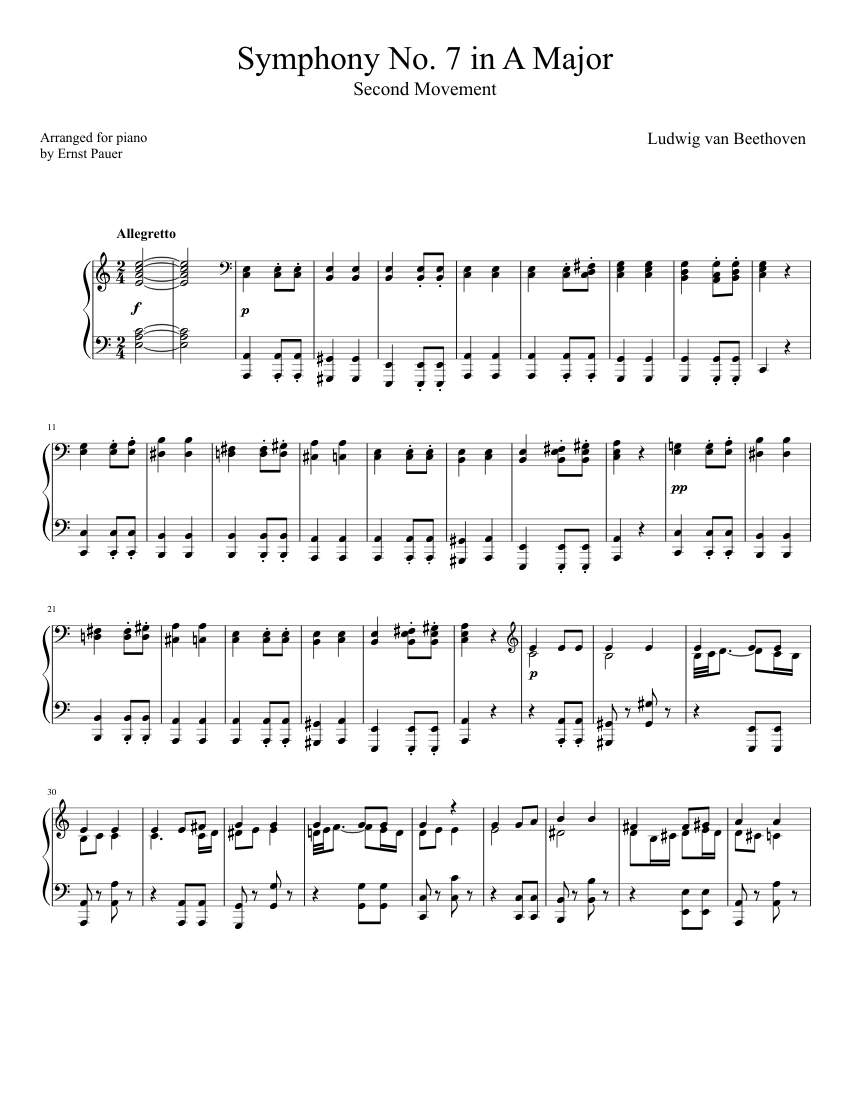

- #BEETHOVEN 7TH SYMPHONY 2ND MOVEMENT A MAJOR FULL#
- #BEETHOVEN 7TH SYMPHONY 2ND MOVEMENT A MAJOR SERIES#
- #BEETHOVEN 7TH SYMPHONY 2ND MOVEMENT A MAJOR TV#
= 104) is in sonata form, and is dominated by lively dance-like dotted rhythms, sudden dynamic changes, and abrupt modulations.
#BEETHOVEN 7TH SYMPHONY 2ND MOVEMENT A MAJOR SERIES#
From the last episode in F major, the movement transitions to Vivace through a series of no fewer than sixty-one repetitions of the note E. The first movement starts with a long, expanded introduction marked Poco sostenuto ( metronome mark: = 69) that is noted for its long ascending scales and a cascading series of applied dominants that facilitates modulations to C major and F major. In addition, the second movement is in A minor with episodes in A major, and the third movement, a scherzo, is in F major. For instance, the first movement is in A major but has repeated episodes in C major and F major. It is also tonally subtle, making use of the tensions between the key centres of A, C and F. The work as a whole is known for its use of rhythmic devices suggestive of a dance, such as dotted rhythm and repeated rhythmic figures. Presto – Assai meno presto ( trio) ( F major, Trio in D major)Ī typical performance time lasts approximately 40 minutes.The Seventh Symphony is in four movements: The symphony is scored for 2 flutes, 2 oboes, 2 clarinets in A, 2 bassoons, 2 horns in A (E and D in the inner movements), 2 trumpets in D, timpani, and strings. The first edition of the score, parts and piano reduction was published in November 1816 by Steiner & Comp.Ī facsimile of Beethoven's manuscript was published in 2017 by Figaro Verlag. at the entrance of a forte he jumped in the air"), and "the friends of Beethoven made arrangements for a repetition of the concert" by which "Beethoven was extricated from his pecuniary difficulties". Spohr made particular mention of Beethoven's antics on the podium ("as a sforzando occurred, he tore his arms with a great vehemence asunder. The piece was very well received, such that the audience demanded the Allegretto movement be encored immediately. The Italian guitar virtuoso Mauro Giuliani played cello at the premiere. The orchestra was led by Beethoven's friend Ignaz Schuppanzigh and included some of the finest musicians of the day: violinist Louis Spohr, composers Johann Nepomuk Hummel, Giacomo Meyerbeer and Antonio Salieri. The program also included the patriotic work Wellington's Victory, exalting the victory of the British over Napoleon's France. In Beethoven's address to the participants, the motives are not openly named: "We are moved by nothing but pure patriotism and the joyful sacrifice of our powers for those who have sacrificed so much for us." The work was premiered with Beethoven himself conducting in Vienna on 8 December 1813 at a charity concert for soldiers wounded in the Battle of Hanau.

īeethoven's life at this time was marked by a worsening hearing loss, which made "conversation notebooks" necessary from 1819 on, with the help of which Beethoven communicated in writing. After the 3rd Symphony, and possibly the 5th as well, the 7th Symphony seems to be another of Beethoven's musical confrontations with Napoleon, this time in the context of the European wars of liberation from years of Napoleonic domination. Pianists may be interested in our arrangements of this music for Piano: By Franz Liszt (advanced), For "Medium Piano" and For "Easy Piano".When Beethoven began composing the 7th symphony, Napoleon was planning his campaign against Russia. The video below illustrates the music with a graphical animation, or you can play the mp3 file and see the sheet music score before downloading.
#BEETHOVEN 7TH SYMPHONY 2ND MOVEMENT A MAJOR FULL#
Here is the Conductor's Full Score and all the individual parts for the following instruments: Flutes, Oboes, Clarinets (in A), Bassoons, Horns (in E), Trumpets (in D), Timpani (tuned in A and E), 1st Violins, 2nd Violins, Violas, Cellos, and Basses.
#BEETHOVEN 7TH SYMPHONY 2ND MOVEMENT A MAJOR TV#
As well as regular concert performances and recordings, the music has also featured on several films and TV shows as diverse as "The King's Speech" and "The Unbrella Academy". This movement is the slow movement and exquisitely formed from a very simple musical idea. Nevertheless the Symphony is full of good humour, good tunes, and a certain rhythmic power which some comentators have described as dance-like. Ludwig van Beethoven: Symphony no.7, 2nd movement - score & parts, midi & mp3īeethoven's 7th Symphony (in A major) was completed in 1812 when the composer was at the height of his powers, though very deaf by this time.


 0 kommentar(er)
0 kommentar(er)
